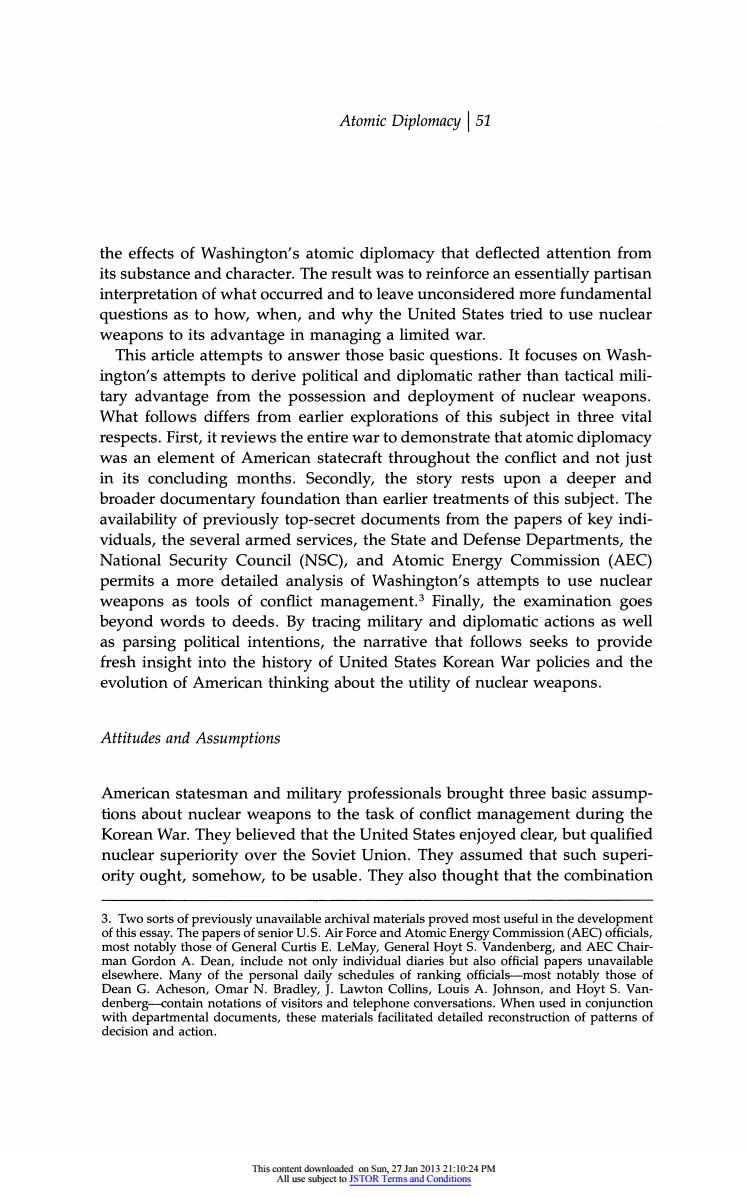正在加载图片...

Atomic Diplomacy 51 the effects of Washington's atomic diplomacy that deflected attention from its substance and character.The result was to reinforce an essentially partisan interpretation of what occurred and to leave unconsidered more fundamental questions as to how,when,and why the United States tried to use nuclear weapons to its advantage in managing a limited war. This article attempts to answer those basic questions.It focuses on Wash- ington's attempts to derive political and diplomatic rather than tactical mili- tary advantage from the possession and deployment of nuclear weapons. What follows differs from earlier explorations of this subject in three vital respects.First,it reviews the entire war to demonstrate that atomic diplomacy was an element of American statecraft throughout the conflict and not just in its concluding months.Secondly,the story rests upon a deeper and broader documentary foundation than earlier treatments of this subject.The availability of previously top-secret documents from the papers of key indi- viduals,the several armed services,the State and Defense Departments,the National Security Council (NSC),and Atomic Energy Commission (AEC) permits a more detailed analysis of Washington's attempts to use nuclear weapons as tools of conflict management.3 Finally,the examination goes beyond words to deeds.By tracing military and diplomatic actions as well as parsing political intentions,the narrative that follows seeks to provide fresh insight into the history of United States Korean War policies and the evolution of American thinking about the utility of nuclear weapons. Attitudes and Assumptions American statesman and military professionals brought three basic assump- tions about nuclear weapons to the task of conflict management during the Korean War.They believed that the United States enjoyed clear,but qualified nuclear superiority over the Soviet Union.They assumed that such superi- ority ought,somehow,to be usable.They also thought that the combination 3.Two sorts of previously unavailable archival materials proved most useful in the development of this essay.The papers of senior U.S.Air Force and Atomic Energy Commission(AEC)officials, most notably those of General Curtis E.LeMay,General Hoyt S.Vandenberg,and AEC Chair- man Gordon A.Dean,include not only individual diaries but also official papers unavailable elsewhere.Many of the personal daily schedules of ranking officials-most notably those of Dean G.Acheson,Omar N.Bradley,J.Lawton Collins,Louis A.Johnson,and Hoyt S.Van- denberg-contain notations of visitors and telephone conversations.When used in conjunction with departmental documents,these materials facilitated detailed reconstruction of patterns of decision and action. This content downloaded on Sun,27 Jan 2013 21:10:24 PM All use subject to JSTOR Terms and ConditionsAtomic Diplomacy |51 the effects of Washington's atomic diplomacy that deflected attention from its substance and character. The result was to reinforce an essentially partisan interpretation of what occurred and to leave unconsidered more fundamental questions as to how, when, and why the United States tried to use nuclear weapons to its advantage in managing a limited war. This article attempts to answer those basic questions. It focuses on Washington's attempts to derive political and diplomatic rather than tactical military advantage from the possession and deployment of nuclear weapons. What follows differs from earlier explorations of this subject in three vital respects. First, it reviews the entire war to demonstrate that atomic diplomacy was an element of American statecraft throughout the conflict and not just in its concluding months. Secondly, the story rests upon a deeper and broader documentary foundation than earlier treatments of this subject. The availability of previously top-secret documents from the papers of key individuals, the several armed services, the State and Defense Departments, the National Security Council (NSC), and Atomic Energy Commission (AEC) permits a more detailed analysis of Washington's attempts to use nuclear weapons as tools of conflict management.3 Finally, the examination goes beyond words to deeds. By tracing military and diplomatic actions as well as parsing political intentions, the narrative that follows seeks to provide fresh insight into the history of United States Korean War policies and the evolution of American thinking about the utility of nuclear weapons. Attitudes and Assumptions American statesman and military professionals brought three basic assumptions about nuclear weapons to the task of conflict management during the Korean War. They believed that the United States enjoyed clear, but qualified nuclear superiority over the Soviet Union. They assumed that such superiority ought, somehow, to be usable. They also thought that the combination 3. Two sorts of previously unavailable archival materials proved most useful in the development of this essay. The papers of senior U.S. Air Force and Atomic Energy Commission (AEC) officials, most notably those of General Curtis E. LeMay, General Hoyt S. Vandenberg, and AEC Chairman Gordon A. Dean, include not only individual diaries but also official papers unavailable elsewhere. Many of the personal daily schedules of ranking officials-most notably those of Dean G. Acheson, Omar N. Bradley, J. Lawton Collins, Louis A. Johnson, and Hoyt S. Vandenberg-contain notations of visitors and telephone conversations. When used in conjunction with departmental documents, these materials facilitated detailed reconstruction of patterns of decision and action. This content downloaded on Sun, 27 Jan 2013 21:10:24 PM All use subject to JSTOR Terms and Conditions